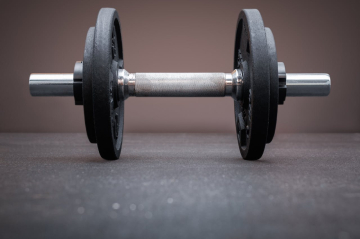The vertical jump is an essential skill in many sports, such as basketball, volleyball, and track and field. Improving your vertical jump will not only make you more competitive in these sports, but it can also improve your strength, power, and overall fitness. This article will guide you through a complete routine designed to increase your vertical jump, addressing key aspects such as strength training, plyometrics, technique, and recovery.
Fundamentals of the Vertical Jump.
Before delving into the routine, it is crucial to understand the fundamentals of the vertical jump. This explosive movement relies heavily on the strength and power generated by the leg and core muscles. The main muscles involved include the glutes, quadriceps, hamstrings and calves. Additionally, proper technique and good flexibility are essential to maximize jump height and prevent injury.
Key Components of the Routine.
An effective routine to improve vertical jump should include several components:
- Strength Training: Strengthen the main muscles involved in jumping.
- Plyometrics: Explosive exercises that improve power and the muscles' ability to generate force quickly.
- Technique: Perfect jumping mechanics to maximize efficiency and height.
- Flexibility and Mobility: Keep muscles and joints flexible to prevent injuries and improve range of motion.
- Recovery: Allow the body to recover properly to avoid overtraining and injury.
Strength Training.
Strength training is essential to improve vertical jump. Here are some key exercises to include in your routine:
Squats
Squats are one of the most effective exercises to strengthen leg muscles. You can do barbell squats, front squats, or bodyweight squats.
Exercise: Barbell squats.
- Repetitions and sets: 4 sets of 8-12 repetitions.
- Technique: Make sure to keep your back straight and heels on the ground as you go down and up.
Deadlifts (Deadlifts).
The deadlift works the glutes, hamstrings and lower back, all crucial for a powerful jump.
Exercise: Conventional deadlift.
- Repetitions and series: 4 sets of 6-10 repetitions.
- Technique: Keep your back straight and avoid rounding your shoulders when lifting the weight.
Heel Raises (Calf Raises).
The calves play an important role in the final push of the jump.
Exercise: Weighted calf raises.
- Repetitions and series: 3 sets of 15-20 repetitions.
- Technique: Perform the exercise on a step to obtain full range of motion.
Plyometrics.
Plyometrics improve your muscles' ability to generate force quickly, which is crucial for an explosive vertical jump.
Box Jumps.
Box jumps develop explosive power in the legs.
Exercise: Box jumps.
- Repetitions and series: 3 series of 10-15 jumps.
- Technique: Make sure you use a box of appropriate height and land softly with your knees slightly bent.
Deep Jumps (Depth Jumps).
This exercise improves your muscles' ability to absorb and generate force quickly.
Exercise: Deep jumps from a box.
- Repetitions and series: 3 sets of 8-10 repetitions.
- Technique: Jump off a box, land softly, then immediately jump up.
Plyometric Hurdle Jumps.
Jumping over obstacles develops strength and speed at takeoff.
Exercise: Plyometric jumps over obstacles.
- Repetitions and series: 3 series of 8-12 jumps.
- Technique: Make sure you jump with both legs and maintain a controlled posture when landing.
Technique.
Proper technique is crucial to maximizing your vertical jump. Here are some tips to improve your technique:
Takeoff Position.
- Tip: Keep your feet shoulder-width apart and your knees slightly bent.
- Exercise: Practice vertical jumps from a static position, focusing on correct posture.
Use of the Arms.
- Tip: Use your arms to generate momentum. Swing your arms back and then forward and up as you jump.
- Exercise: Perform vertical jumps with emphasis on arm movement.
Coordination.
- Tip: Coordination between leg extension and arm movement is key.
- Exercise: Perform jumps in slow motion to work on coordination.
Flexibility and Mobility.
Maintaining flexibility and mobility is essential to prevent injuries and improve performance.
Dynamic Stretches.
Perform dynamic stretches before your workouts to prepare your muscles and joints.
Exercise: Twisting lunges.
- Repetitions and series: 2 sets of 10-12 repetitions per leg.
- Technique: Make sure you perform the stretch in a controlled manner.
Static Stretches.
Perform static stretches after your workouts to improve flexibility.
Exercise: Hamstring stretch.
- Duration: Hold each stretch for 30 seconds.
- Technique: Do not bounce during the stretch, maintain gentle tension.
Recovery.
Recovery is essential to allow your muscles to repair and strengthen.
Adequate Rest.
- Make sure you get enough sleep so your body can recover properly.
- Recommendation: Sleep at least 7-9 hours per night.
Nutrition.
- A balanced diet rich in protein is crucial for muscle recovery.
- Recommendation: Consume lean proteins, complex carbohydrates and healthy fats.
Massages and Movement Therapy.
- Massage and movement therapy can help reduce muscle tension and improve recovery.
- Recommendation: Consider receiving sports massages regularly.
Example of a Weekly Routine.
Here's an example of how you could structure your training week:
Monday: Strength Training
- Barbell squats: 4x8-12
- Deadlift: 4x6-10
- Heel raises: 3x15-20
Tuesday: Plyometrics
- Box jumps: 3x10-15
- Deep jumps: 3x8-10
- Plyometric jumps over obstacles: 3x8-12
Wednesday: Flexibility and Technique
- Dynamic and static stretches
- Vertical jumps with emphasis on technique: 3x10
Thursday: Strength Training
- Front squats: 4x8-12
- Romanian deadlift: 4x6-10
- Weighted calf raises: 3x15-20
Friday: Plyometrics
- Box jumps: 3x10-15
- Deep jumps: 3x8-10
- Plyometric jumps over obstacles: 3x8-12
Saturday: Flexibility and Recovery
- Dynamic and static stretches
- Massages and movement therapy
Sunday: Rest
- Full rest day
Improving your vertical jump is a process that requires dedication and consistency. By incorporating a combination of strength training, plyometric exercises, proper technique, flexibility, and proper recovery, you can significantly increase your jumping ability. Remember that patience is key, and that results will come with time and constant effort.






